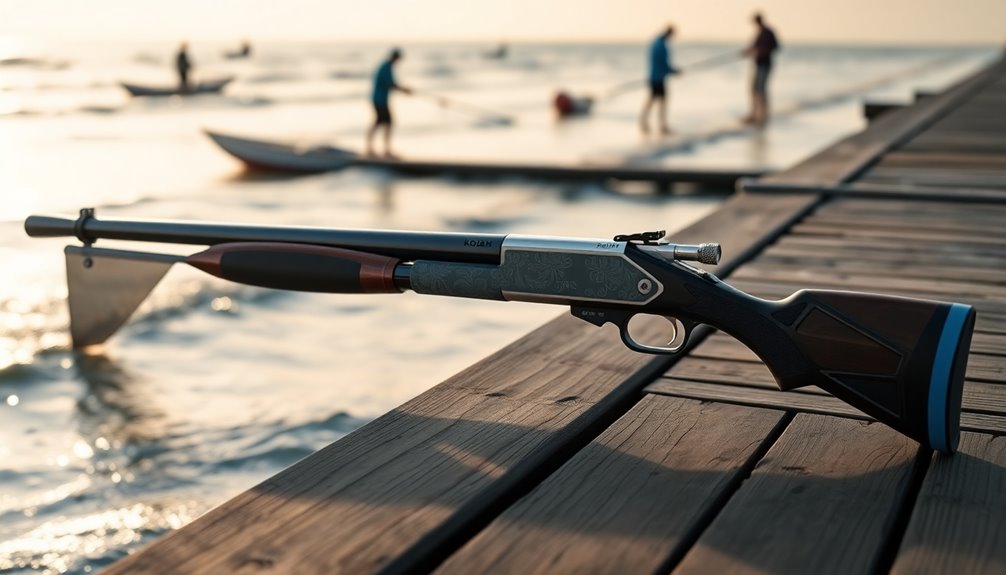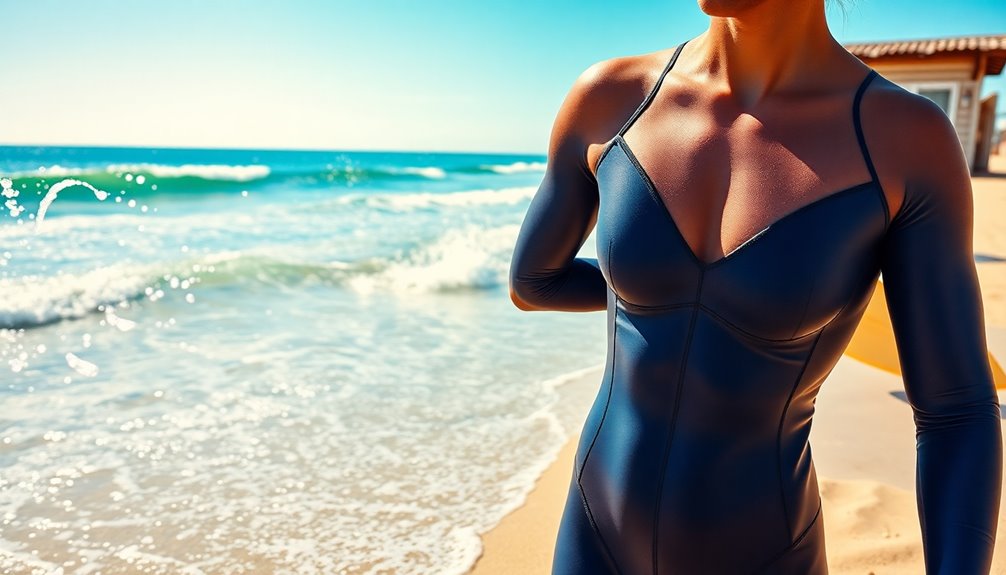Lobster hunting is an exciting adventure where you can use skill and strategy to catch a delicious meal! Lobsters love rocky bottoms in cooler Atlantic waters, and they're most active at night. You'll need some essential gear, like a tickle stick and a good boat, to help you out. Knowing how to approach lobsters without startling them can make all the difference. It's also important to follow local rules to keep lobster populations healthy. After your catch, you'll get to enjoy a scrumptious meal! Keep going to discover more tips and tricks for a successful lobster hunt!
Key Takeaways
- Lobsters prefer rocky bottoms for hiding, making these areas prime hunting spots during summer and fall when activity peaks.
- Nighttime hunting is most effective; approach lobsters gently from behind using tickle sticks and nets to coax them out.
- Legal permits are essential for lobster hunting, ensuring compliance with size limits and sustainable practices to protect the population.
- Fresh bait, like clams or squid, enhances catch rates, especially when using traps or during high tides.
- Properly preparing lobsters is key; boiling or steaming them shortly after capture yields the best flavor and texture for a delicious meal.
Ideal Lobster Habitats
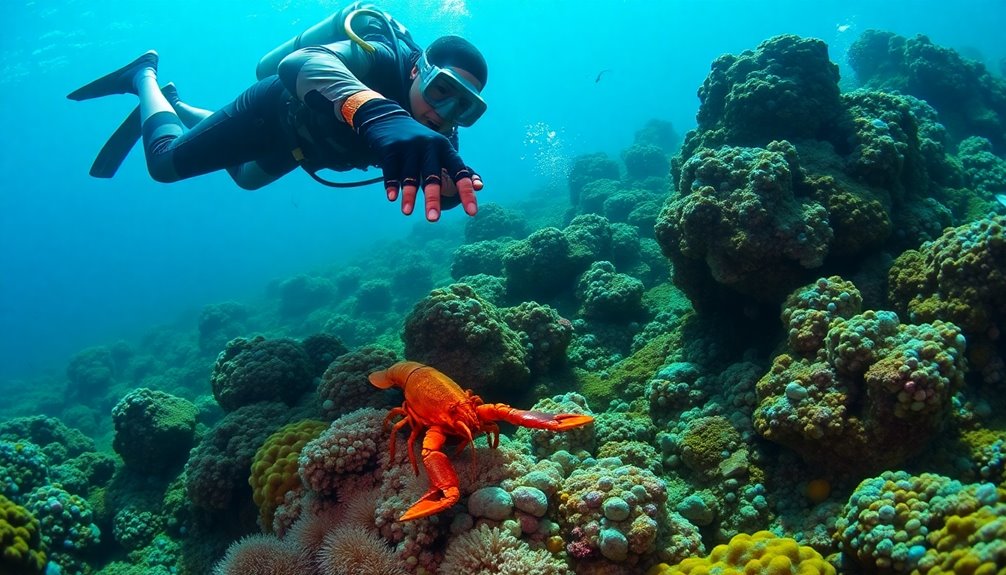
Lobsters thrive in diverse marine environments, but their ideal habitats are notably specific. You'll find them along the Atlantic coast of North America, from Labrador, Canada, all the way to North Carolina, USA. They love the New England coast, where commercial fisheries flourish from Long Island Sound to Newfoundland. The Gulf of Maine and around Nova Scotia are spots with high lobster concentrations, especially in Maine and Massachusetts.
Lobsters prefer waters less than 50 meters deep, but they can dive much deeper if needed. They enjoy temperatures between 15 and 18°C (59-64°F) and salinities of 20-25 ppt. Rocky bottoms are their favorite homes, offering plenty of places to hide. Young lobsters often settle in cobble areas, while larger ones might venture to deeper waters but return to shallower spots as the seasons change. Larger adult lobsters typically inhabit deeper waters but migrate to shallower areas seasonally.
During the day, lobsters like to chill in burrows or crevices, coming out at night to hunt for food. They're clever critters, quickly retreating into their shelters when a predator approaches.
Knowing where lobsters like to hang out can make your hunting adventure much more exciting!
Optimal Lobster Hunting Times

Knowing where lobsters like to hide sets the stage for an exciting hunting experience, but timing is just as important. For the best results, head out at night! Lobsters are most active after the sun sets, crawling around the ocean floor. You'll have a higher chance of catching them between late evening and early morning.
During the day, you can still find lobsters, but it takes more effort. They'll be tucked away in their hiding spots, so you'll need to search carefully. Lobsters typically inhabit rocky crevices, making these locations prime spots to check during your hunt.
Tides play a key role too. High tide is your friend, bringing lobsters closer to shore and filling more holes. It's the perfect time to spot them. Slack tide can also be helpful since the water's calmer, making it easier to see these critters.
Summer and fall are the peak seasons for lobster hunting. From late July to late December, you'll find plenty of lobsters swimming about.
Essential Lobstering Gear
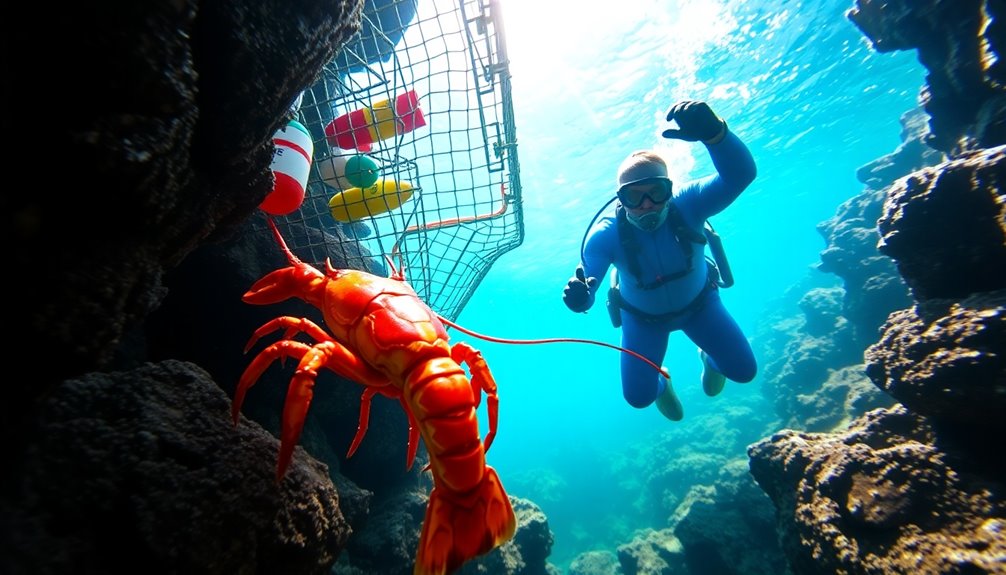
When you head out for a lobster hunting adventure, having the right gear can make all the difference in your success.
First, if you're on a boat, you'll want a narrow, flat-hulled fishing or lobster boat. This type of boat offers speed and stability, making it easier to reach those prime lobster spots. Selecting the right vessel can significantly impact your lobstering efficiency.
Next, traps are essential for catching lobsters in deeper waters. You'll also need a bait bag to hold tasty treats like herring or bluefish, which attract the lobsters. Once you catch them, a banding tool helps keep their claws together, so you don't get pinched!
If you prefer diving, grab a tickle stick to gently coax lobsters out from their hiding spots. A snare pole can help you catch them without getting too close.
Don't forget lobster gloves to protect your hands from spines and claws!
Make sure you have a measuring gauge to check size limits and a V-notch tool to mark female lobsters for conservation.
Lastly, a cooler or dive bag is perfect for transporting your catch home.
With the right gear, you're all set for an exciting day of lobster hunting!
Effective Catching Techniques

Effective catching techniques can significantly enhance your lobster hunting experience.
First, you'll want to locate lobsters hiding in caves, cracks, or under rocks, especially during the day when they're less active. When you approach, sneak in from behind since lobsters can see 180 degrees around them! You can use your hand to get their attention while your other hand moves in for the catch.
If you prefer a tickle stick and net, place the net behind the lobster. Gently coax it out with the stick, and as it swims backward, it'll move right into the net! Remember to flip the net to prevent escape and hold it tight. Using a tickle stick is essential for coaxing lobsters out of their hiding spots.
For a snare, loop it around the lobster and pull to secure your catch. Bully nets are great for catching larger quantities quickly, especially at night!
If you're feeling adventurous, try bait and line fishing with fresh or frozen bait like clams or squid. Store your bait in a dedicated freezer for best results.
With these techniques, you’re well on your way to a successful day of lobster hunting! Happy hunting! Remember to pack a sturdy spearfishing knife to help you quickly dispatch any lobsters you catch. And always make sure to follow local laws and regulations when hunting for these underwater delicacies. With the right gear, knowledge, and respect for the environment, you’ll have a fantastic lobster hunting adventure.
Legal Regulations Overview
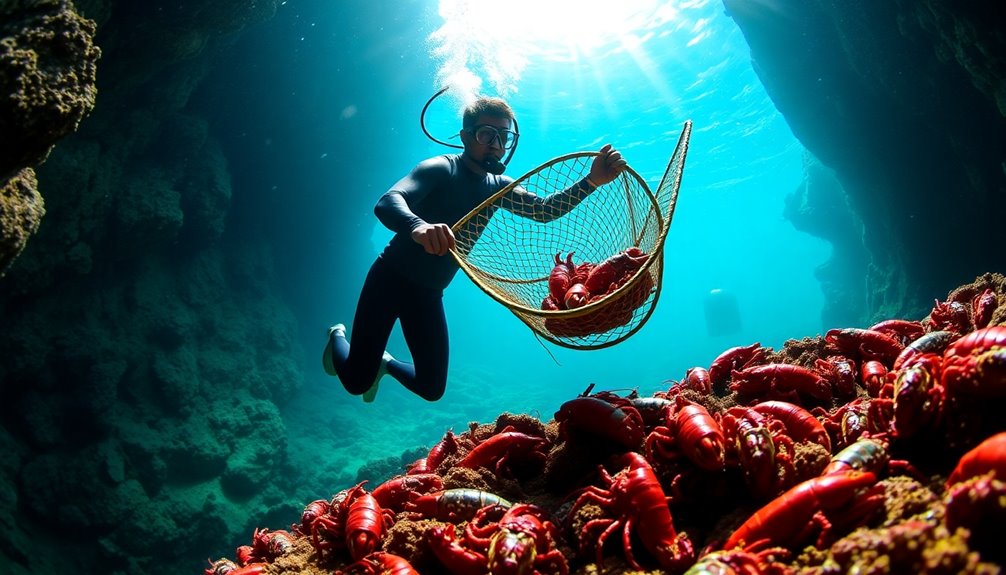
Navigating the legal regulations surrounding lobster hunting is crucial for both recreational and commercial fishers. First, you'll need a permit. If you're out for fun, a Lobster Recreational Permit costs just $10. This lets you set up to 5 lobster pots and keep up to 6 lobsters a day!
For those looking to fish commercially, it gets a bit more complicated. You'll need a Lobster Commercial Permit, which costs $150 for residents and $225 for non-residents. Lobster habitat often influences where you can set your pots, so be sure to research the best locations.
It's important to know the rules about size, too. Lobsters have minimum and maximum size limits, so make sure you land them live and whole. Also, remember, no harvesting egg-bearing females! If you catch one, notch her tail before sending her back to the sea.
Finally, don't forget about the federal rules! If you're fishing in federal waters, you'll need a federal lobster limited access permit. And make sure to report your catches regularly.
Following these regulations helps keep lobster populations healthy and ensures everyone can enjoy this tasty treat for years to come! Happy hunting!
Tips for Successful Hunting
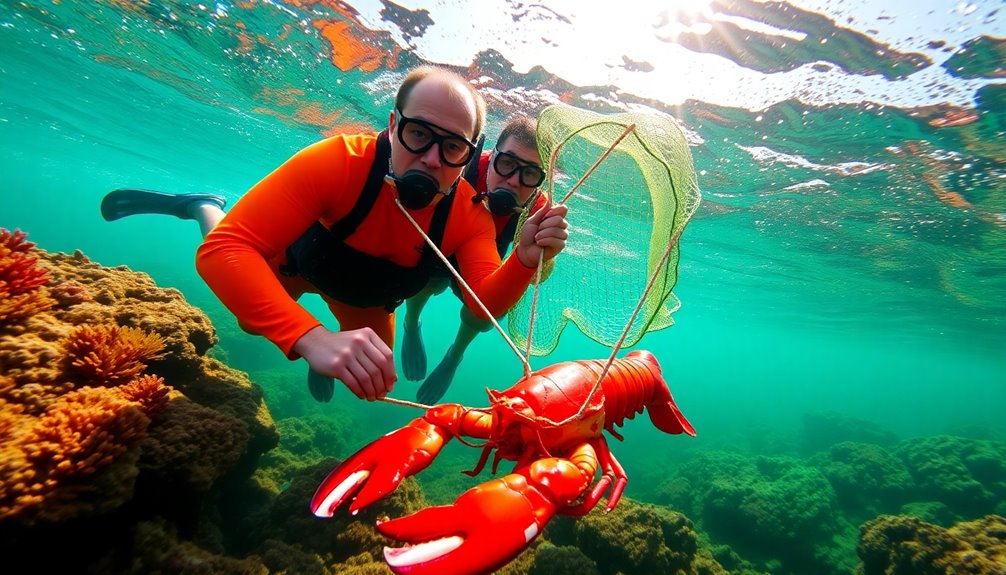
Successful lobster hunting hinges on your ability to blend preparation with keen observation. First, make sure you're equipped with the right gear. Bring along lobster nooses, nets, and tickle sticks to help you catch lobsters hiding in their rocky homes. Don't forget your lobster gloves to protect your hands!
When diving, look carefully under rocks and in eel grass beds. Lobsters love to hide in small cracks, so press your mask into the grass and keep an eye out. Remember, they often hide in shallow waters too, so explore those areas. Additionally, strong tide swings can increase lobster visibility, making your search more fruitful.
Approach quietly; lobsters can be startled easily. Use one hand to distract them while you reach in with the other. Pin the lobster at the mid-tail to control it better, and make your move quick to avoid escapes.
If you're diving with friends, work as a team! Take turns using your gear and support each other. Be patient; sometimes it takes several attempts to catch one lobster.
Keep in mind the currents and waves that can make things tricky. With preparation and teamwork, you'll be ready for a successful hunt!
Night vs. Day Hunting
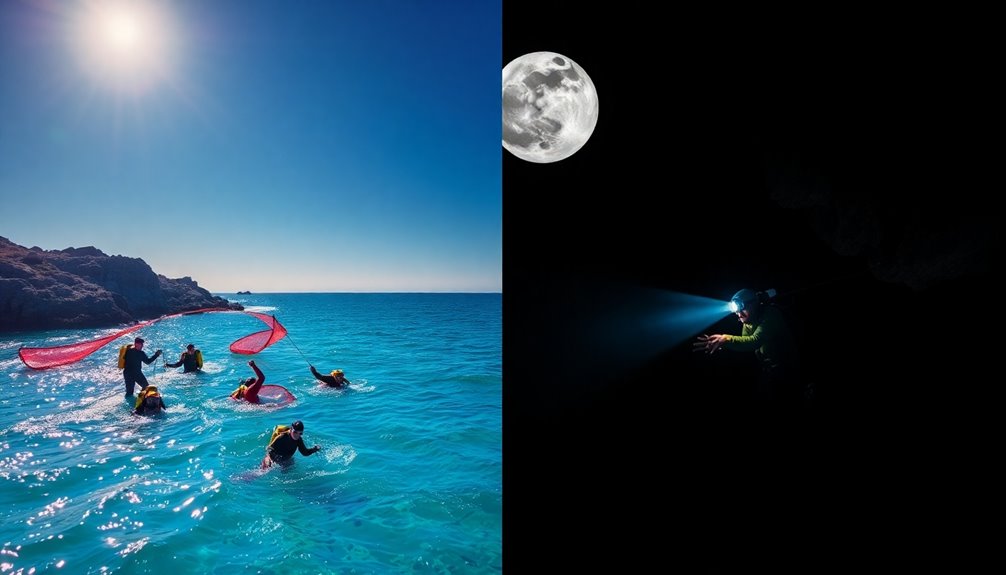
When it comes to lobster hunting, choosing between night and day can significantly impact your success. If you dive at night, you'll find lobsters more active since they're nocturnal. They leave their hiding spots to search for food, making them easier to catch.
However, night diving has its challenges. You'll need lights to see, but be careful—those lights might alert the lobsters! It's best to have some experience with night diving and lobster hunting to really shine. Additionally, during the mating season, which lasts from November to May, lobsters are often more concentrated in certain areas, making them easier to locate.
On the other hand, day hunting has its perks too! During the day, lobsters hide deep in holes and under structures to avoid predators, so you'll need to scout for places like jetties and ledges.
You'll want to choose spots that aren't too deep, as they're easier to reach. Daytime hunting requires a different technique. You might trap lobsters with your hands or catch them as they exit their hiding spots.
Plus, remember that some areas have restrictions, limiting your tools. Ultimately, whether you choose night or day, both can lead to a rewarding catch. Happy hunting!
Scouting and Spot Selection

Before you dive into lobster hunting, scouting and spot selection are crucial for a fruitful outing. First, look for areas outside coral reefs, as these can be tricky to access. Jetties are great spots, but try to focus on structures slightly off the jetty to avoid deep holes where lobsters can escape. Shallow ledges in surf zones are often overlooked but can be very promising!
You can use depth sounders to locate bumps on the sea floor or swim along the terrain's contours to discover broken rock formations. Keep an eye out for eel grass, wrecks, and debris, as they provide excellent hiding spots for lobsters. You want to find areas with minimal surf to scout those shallow ledges.
When assessing your chosen spots, think about accessibility and whether lobsters have limited escape routes. Look for rock piles or burrowing areas with darker mud and shells, as these indicate lobster presence. Additionally, understanding lobster behavior can help you predict where they might be hiding.
Also, check for other lobsters nearby, since they often hang out in groups. Remember to avoid spots crowded with other marine life that might scare your tasty targets away! Happy hunting!
Understanding Lobster Behavior

Understanding lobster behavior is essential for anyone looking to improve their hunting skills. You'll find that lobsters have changed their favorite spots over the years. Instead of hiding under rocks, they now prefer open spaces or soft sediments. It's fascinating! Recent research indicates that lobster population density has declined, leading to more spread out distributions.
Lobsters make seasonal moves, heading offshore in the fall and returning to their summer homes in late spring. Knowing this can help you plan your hunt.
When you're underwater, pay attention to their antennae. If they face away from you, they're unaware of your presence. But if they point towards you, they know you're there! They might need a little distraction to catch them.
Plus, lobsters are quick to hide, scurrying back to their holes if they sense danger.
Lobsters are always on the lookout for food and can snap up prey in a flash. They often prefer places with escape routes, making it tricky to catch them.
With fewer young lobsters around, you'll mostly see bigger adults. Understanding these habits will give you the upper hand as you embark on your lobster hunting adventure!
Preparing Your Catch

After successfully catching lobsters, the next step is preparing your catch for cooking. First, keep your lobsters alive until you're ready to prepare them. If you don't have a live game well on your boat, wrap them in a seawater-soaked towel or kelp to keep them moist. Avoid buckets or ice chests filled with seawater, as this can stress them and cause them to die quickly. It's important to remember that lobsters can survive out of water for 24 hours or more if kept cool and moist.
When you're ready to cook, boiling is the most common method. For the first pound, boil them for about five minutes, adding three more minutes for each additional pound. If you prefer, you can also steam the lobsters. For steaming, you'll need to slice the meat loose from the shell first.
If you want to save some for later, freezing is a great option! Cooked lobsters last longer in the freezer, so consider cooking them before freezing. Make sure to seal them tightly to avoid freezer burn.
Lastly, when extracting the tail meat, slice it loose from the shell carefully. Trim any skin and you're all set! Enjoy your delicious lobster meal, knowing you did the hard work to catch it!
Frequently Asked Questions
What Is the Best Season for Lobster Hunting?
The best season for lobster hunting is late June through December.
During this time, lobsters are super active because they're searching for food after molting. You'll find the most lobsters then, with about 80% to 85% of the yearly catch happening in the summer and fall.
It's exciting! The lobsters are easier to catch, and their appetites are big, making this the perfect time for fishing enthusiasts like you!
How Do Weather Conditions Affect Lobster Activity?
Weather conditions play a big role in lobster activity! When temperatures rise, lobsters become more active and hungry.
They love to roam during the night, but they might come out in the day if food's around. Storms can stir things up, making lobsters change locations or dive deeper.
Even the moon can affect their behavior! So, if you're out there, keep an eye on the weather for the best chances of a great catch!
Can I Catch Lobster Without a Boat?
Yes, you can catch lobster without a boat!
You'll just need to head to shallow waters, like those in the Florida Keys. Grab a snorkel or a paddleboard, and look for lobsters hiding near rocks or coral.
Use a tickle stick to gently coax them out, then catch them with a net. Don't forget your gloves for protection!
It's a fun adventure, and you could even find lobsters just a few yards from shore!
What Are the Best Bait Options for Lobster Fishing?
When you're fishing for lobsters, the right bait can make all the difference! Oily fish like herring, bluefish, and mackerel are great choices because they create a strong scent that attracts lobsters.
You can also try using chunks of bonito or skipjack if you're in California.
Don't forget to keep your bait fresh and stored properly to ensure it works its magic.
Happy fishing, and good luck catching those tasty lobsters!
How Do I Properly Store Lobsters After Catching?
After catching lobsters, you should store them right away!
First, refrigerate them at about 40 degrees F. Don't freeze them; that ruins the taste and texture.
Wrap the lobsters in damp paper or seaweed, then place them in an open container or ventilated bag.
Make sure they can breathe and avoid water!
Keep them cool and moist to keep them happy until you're ready to cook them.
Enjoy your catch!
Conclusion
So, there you have it! Lobster hunting is an exciting adventure that combines skill and strategy. By understanding where to find lobsters, what gear to use, and the best times to hunt, you can enjoy a rewarding experience. Remember to follow the rules and respect the ocean. Whether you choose to hunt at night or during the day, the thrill of catching your own lobster is unforgettable. Get out there, have fun, and enjoy your delicious catch!




